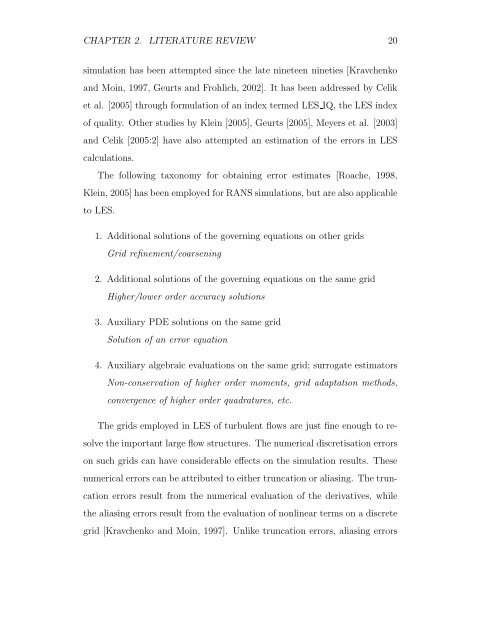Quality Criteria for Large Eddy Simulation - Turbulence Mechanics ...
Quality Criteria for Large Eddy Simulation - Turbulence Mechanics ...
Quality Criteria for Large Eddy Simulation - Turbulence Mechanics ...
You also want an ePaper? Increase the reach of your titles
YUMPU automatically turns print PDFs into web optimized ePapers that Google loves.
CHAPTER 2. LITERATURE REVIEW 20<br />
simulation has been attempted since the late nineteen nineties [Kravchenko<br />
and Moin, 1997, Geurts and Frohlich, 2002]. It has been addressed by Celik<br />
et al. [2005] through <strong>for</strong>mulation of an index termed LES IQ, the LES index<br />
of quality. Other studies by Klein [2005], Geurts [2005], Meyers et al. [2003]<br />
and Celik [2005:2] have also attempted an estimation of the errors in LES<br />
calculations.<br />
The following taxonomy <strong>for</strong> obtaining error estimates [Roache, 1998,<br />
Klein, 2005] has been employed <strong>for</strong> RANS simulations, but are also applicable<br />
to LES.<br />
1. Additional solutions of the governing equations on other grids<br />
Grid refinement/coarsening<br />
2. Additional solutions of the governing equations on the same grid<br />
Higher/lower order accuracy solutions<br />
3. Auxiliary PDE solutions on the same grid<br />
Solution of an error equation<br />
4. Auxiliary algebraic evaluations on the same grid; surrogate estimators<br />
Non-conservation of higher order moments, grid adaptation methods,<br />
convergence of higher order quadratures, etc.<br />
The grids employed in LES of turbulent flows are just fine enough to re-<br />
solve the important large flow structures. The numerical discretisation errors<br />
on such grids can have considerable effects on the simulation results. These<br />
numerical errors can be attributed to either truncation or aliasing. The trun-<br />
cation errors result from the numerical evaluation of the derivatives, while<br />
the aliasing errors result from the evaluation of nonlinear terms on a discrete<br />
grid [Kravchenko and Moin, 1997]. Unlike truncation errors, aliasing errors
















